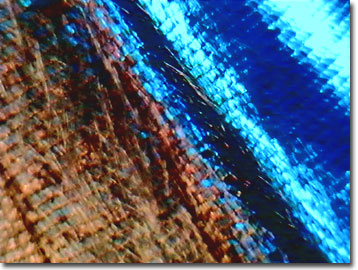Butterfly Wing Scale Digital Image Gallery
Blue Morpho Butterfly
In a sea of green vegetation, blue morpho butterflies sparkle like jewels. As one of the most iridescent forms in the insect world, the large lepidopterans must not expose their wing tops for long if they want to avoid notice. Blue morphos, which inhabit the dwindling rainforest canopies of South and Central America, frequently suffer from commercial exploitation.

Although brilliantly hued, members of the species Morpho menelaus are not in constant danger of predation. The butterflies beat their long wings so slowly that the eye-catching blue tops only appear after long intervals, making them difficult for predators to track. The brown undersides that are more frequently exposed are not as vulnerable. Their earth-tone shade and bronze-colored eyespots help them blend into the environment of the tropical rainforest.
Interestingly, blue morpho caterpillars are not blue. Instead, the larvae are reddish-brown with bright patches of lime-green on their backs. The nocturnal feeders form communities, but are extremely cannibalistic. The peculiarity may be a type of population control since the larvae appear to have few natural enemies. Tiny hairs that cause irritation when touched protect their bodies from most species. Those that survive the hunger of their brethren in the larval stage maintain the familial bond and pupate together.
As adults, blue morphos are sometimes competitive, but not to the extent of cannibalism. The butterflies drink the juices of rotting fruits with their long straw-like proboscises. The strategy is well suited for the tropical rainforests, where finding blooming flowers of a specific type is not always easy. During flight, males tend to exhibit aggressive behavior if another male comes too close. Yet, at a watering place two males can sit close together without discord. In fact, male blue morpho butterflies frequently roost together at night, tending to repeatedly visit the same location.
Contributing Authors
Cynthia D. Kelly, Shannon H. Neaves, Laurence D. Zuckerman, and Michael W. Davidson - National High Magnetic Field Laboratory, 1800 East Paul Dirac Dr., The Florida State University, Tallahassee, Florida, 32310.
BACK TO THE BUTTERFLY WING SCALE IMAGE GALLERY
BACK TO THE DIGITAL IMAGE GALLERIES
Questions or comments? Send us an email.
© 1995-2025 by Michael W. Davidson and The Florida State University. All Rights Reserved. No images, graphics, software, scripts, or applets may be reproduced or used in any manner without permission from the copyright holders. Use of this website means you agree to all of the Legal Terms and Conditions set forth by the owners.
This website is maintained by our
Graphics & Web Programming Team
in collaboration with Optical Microscopy at the
National High Magnetic Field Laboratory.
Last Modification Friday, Nov 13, 2015 at 01:19 PM
Access Count Since January 21, 2003: 13599
Visit the website of our partner in introductory microscopy education:
|
|
